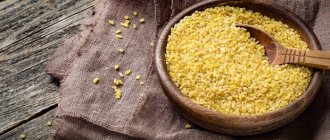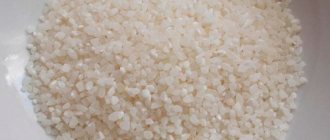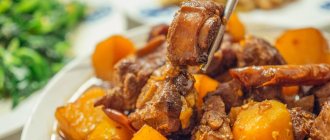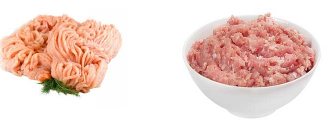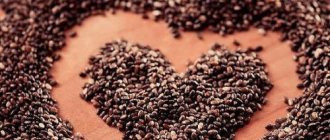Many of those who adhere to a healthy diet diligently avoid “fast” carbohydrates and prefer oatmeal or buckwheat porridge as a side dish or a hearty breakfast. But comparing these cereals with the less popular lentils does not speak in their favor.
In the article we will talk about the main differences in the chemical composition of products, their energy and nutritional value, health properties, consider contraindications to the consumption of buckwheat, oatmeal and lentils and the opinions of nutritionists on their account.
What are lentils, what does it look like, what does it taste like?
Lentils are a legume that has recently become increasingly popular. Lentils are used to make mashed porridge, soups, other side dishes, stews, salads, even bread. Lentils are beneficial for both women and men. You should include lentils in your diet as often as possible in order to bring your body the maximum of beneficial microelements.
Benefits of lentils:
- The culture is rich in dietary fiber, which is unique in that it can normalize blood cholesterol levels.
- People with diabetes should eat lentils; this culture does not increase blood sugar due to the large amount of “light” carbohydrates.
- Fiber, which lentils are rich in, helps get rid of stool disorders and constipation, as well as problems associated with poor nutrition.
- Fiber also helps reduce appetite and satiate, thereby helping you lose weight and lose weight.
- The high content of microelements in lentils improves the functioning of the cardiovascular system: strengthens blood vessels and the heart muscle.
Possible harm of lentils:
- Excessive consumption of lentils can cause digestive problems due to the fact that this crop contains too much protein.
- Lentils can cause flatulence and therefore should be eaten with caution by those who are painfully experiencing increased gas formation in the intestines.
- Gout is a disease that warns a person against excessive consumption of lentils.
- Those who suffer from dysbiosis should not eat lentils, since the culture is poorly broken down in the stomach.
- Lentils are best eaten separately from meat and dairy products, as the culture prevents the body from absorbing nutrients from other foods, such as zinc, iron or calcium.
Lentils are actively used in folk medicine for:
- Liver treatment – lecithin, an amino acid found in lentils, has a positive effect on the regeneration of liver cells.
- Improving metabolism - for people who are overweight and have poor digestion, eat junk food and suffer from hormonal imbalances.
- Improves blood quality - lentils are rich in iron and it regulates the level of hemoglobin in the blood.
- Treatment of urolithiasis - for the natural release of the liver from the bladder, kidneys, breaking up stones.
- Treatment of vitamin deficiency - lentils are rich in vitamins and minerals necessary for the normal functioning of the body.
What can be prepared from lentils:
- Soups - red lentils are ideal for first courses, as they have a smaller appearance and cook quickly. You can also use green lentils.
- Add to salads - add any lentils, boiled or sprouted. The culture goes perfectly with vegetables, other legumes, and cabbage.
- Fry – boiled or sprouted lentils until half cooked can be fried with garlic in vegetable oil.
- Prepare the sauce - this sauce can be combined with other cereals and legumes.
- Porridges and side dishes - boiled in water or broths, pureed in a blender.
IMPORTANT: In terms of taste, lentils resemble peas. The red crop has a more pronounced nutty taste, the green one is slightly less bright, and the black one is less reminiscent of beans.
What are the benefits of lentils?
Calorie content and dietary fat, glycemic index
Calorie content is the first thing people who want to lose weight pay attention to. But the ratio of BZHU and the glycemic index is no less important.
Nutritional and energy value of buckwheat
The glycemic index of dry cereal is from 50 to 60. When boiled, due to water, the indicator is reduced to 40-50.
| Per 100 g of product | Dry kernel | Boiled core | Prodel dry | Dry green buckwheat |
| Calorie content, kcal | 313 | 101 | 300 | 296 |
| Proteins, g | 12,6 | 4,2 | 9,5 | 10,8 |
| Fats, g | 3,3 | 1,1 | 2,3 | 3,2 |
| Carbohydrates, g | 62,1 | 18,6 | 60,4 | 55 |
Oatmeal
The glycemic index of oatmeal varies from 55 to 60, oatmeal with milk - 60, water - 40.
| Per 100 g of product | Dry oat flakes | Extra No. 1,2 | Extra No. 3 | Hercules | Oatmeal on water |
| Calorie content, kcal | 305 | 310 | 360 | 352 | 88 |
| Proteins, g | 11 | 16 | 16 | 12,3 | 3 |
| Fats, g | 6,2 | 10 | 10 | 6,2 | 1,7 |
| Carbohydrates, g | 50 | 40 | 50 | 62 | 15 |
Lentils
The glycemic index of dry lentils is from 38 to 41, of the finished product - 25.
| Per 100 g of product | Brown lentils | Red lentils | Black lentils | |||
| dry | boiled | dry | boiled | dry | boiled | |
| Calorie content, kcal | 297 | 105 | 318 | 100 | 324 | 145 |
| Proteins, g | 24,3 | 8,8 | 23,8 | 7,6 | 35 | 17 |
| Fats, g | 1,9 | 0,7 | 1,3 | 0,4 | 2 | 0,5 |
| Carbohydrates, g | 48,8 | 6,9 | 56,3 | 17,5 | 53 | 20 |
Which has more calories?
When prepared, buckwheat and lentils are higher in calories than oatmeal:
- boiled lentils - 105-145 kcal;
- buckwheat porridge on water - 101 kcal;
- oatmeal - 88 kcal.
Cooking oatmeal and buckwheat with milk increases the calorie content of porridges to 130 and 140 kcal, respectively. At the same time, milk buckwheat porridge is more dietary than cereal simply doused with milk. The energy value of this dish is 198 kcal.
What's best for losing weight
Oatmeal is a classic option for a hearty, high-carbohydrate breakfast, unless it's an instant cereal. In the latter case, fast carbohydrates are processed by the body in a short time, and the person feels hungry again.
Reference. Hollywood actress Anne Hathaway resorted to an oatmeal mono-diet in preparation for her Oscar-winning role in the film Les Misérables.
Despite the higher calorie content than oatmeal, lentils have a low glycemic index, that is, they do not cause a sharp jump in blood sugar, are rich in protein (from 8 to 17 g per 100 g of the finished product), contain practically no fat and give Prolonged feeling of satiety, therefore effective in the fight against excess weight. It is a favorite among vegetarians as an alternative to meat.
Buckwheat is often included in therapeutic diets on medical advice (diet tables). It is also used as a mono-diet for weight loss (for example, with the addition of kefir). The kernel steamed with boiling water is healthier than other varieties, since it preserves the entire set of microelements and vitamins.
Lentils – chemical composition, vitamins, proteins, nutritional value
Lentils are unique in that they are rich in vitamins and minerals that are essential for the body.
| Substance | What is good for the body |
| Vitamin A | Improves the functioning of all internal organs and systems in the body, improves vision, strengthens the immune system. |
| Vitamin B1 | Participates in the most important metabolic processes of the body: protein, fat and water-salt |
| Vitamin B2 | Participates in the work of almost any cell in the body and in all metabolic processes |
| Vitamin B3 | Improves metabolism, strengthens the immune system, strengthens all the body's defenses. |
| Folic acid | Takes part in the development of the circulatory, nervous system and immunity |
| Vitamin E | Improves the condition of nails, hair, skin |
| Potassium | Necessary for the vital functions of all soft tissues, these include blood vessels, muscles, the brain and all internal organs |
| Calcium | Strengthens the skeletal system, teeth, nourishes the soft tissues of the body. |
| Sodium | Maintains a healthy body and ensures normal growth and development |
| Magnesium | Has a beneficial effect on bone growth |
| Phosphorus | Improves performance and metabolism in the body |
| Chlorine | Maintains the acid-base balance of the body at a constant level |
| Bor | Speeds up metabolism by breaking down fat |
| Iron | Increases hemoglobin levels in the blood |
| Iodine | Improves mental performance |
| Cobalt | Takes part in the production of RNA and DNA, promotes bone growth |
| Silicon | Regulates the functioning of the thyroid gland, adrenal glands, pituitary gland, lymph nodes |
| Manganese | Takes part in cell development |
| Copper | Participates in redox processes |
| Molybdenum | Plays a key role in many biological processes |
| Nickel | Takes part in many biochemical processes in the body, lowers blood pressure |
| Fluorine | Strengthens tooth enamel |
| Zinc | Improves “women’s” and “men’s” health |
| Chromium | Maintains normal serum sugar balance |

Composition of lentils
Benefits for the human body
Lentils are an extremely nutritious member of the Legume family, which has many beneficial properties for the human body.
Digestion
Like other legumes, lentils are one of the main products in terms of fiber content, both soluble and insoluble. Both types of dietary fiber have a positive effect on the digestive system. Insoluble fiber absorbs liquid, swells and, once in the intestines, promotes the rapid elimination of processed waste products. Soluble fiber in the body turns into a jelly-like substance, thanks to which the feeling of fullness is maintained for a long time [5].
Sugar and cholesterol concentration
Lentils are able to stabilize two important indicators in the blood - glucose and cholesterol. For individuals with insulin resistance, diabetes or hypoglycemia, this culture is useful as a substance that stabilizes the balance of glucose and insulin. Researchers compared the condition of two groups of people with type 2 diabetes. They took 24 and 50 g of fiber daily. It turned out that those who took more dietary fiber had lower blood glucose levels [6]. In addition, with regular consumption of fiber, the concentration of low-density lipoproteins (better known as “bad” cholesterol) decreased by almost 12.5%.
Metabolism and Cell Health
B vitamins, which are found in abundance in lentils, are involved in the metabolism of amino acids and carbohydrates. Manganese, one of the powerful antioxidants, also contributes to this process. And magnesium, by activating certain enzymes, improves tissue regeneration. Potassium contained in legumes maintains acid-base balance, regulates growth and pressure inside cells.
The cardiovascular system
Scientists conducted an experiment to determine how diet affects the risk of developing coronary heart disease (CHD). As a result of the experiment, which involved over 16 thousand middle-aged people, the following was established: people whose diets are dominated by grains, legumes and vegetables are almost 80% less likely to develop coronary heart disease.
In another study, it became known that people whose diet is rich in fiber, present in large quantities in lentils, are less susceptible to cardiovascular diseases [7]. Last but not least, this is possible thanks to the high concentration of folic acid (B9) and magnesium. Vitamin B9 helps reduce levels of homocysteine, an amino acid that researchers name among the main risk factors for developing heart disease. Magnesium in adequate doses improves the quality of blood flow and also affects the availability of necessary oxygen and nutrients in the blood. A deficiency of this element can cause a heart attack.
The benefits of lentils for the body of men and women
Benefits of lentils for women:
- The rich amino acid content of lentils helps fight breast cancer.
- Acids and amino acids found in culture successfully fight benign and malignant tumors, including uterine tumors.
- Lentils have the unique property of regulating hormonal levels in the body. That is why it is recommended to consume lentils during menstruation and menopause.
- During pregnancy, lentils are useful for women because they nourish the woman’s body and fetus with a mass of useful substances, providing the necessary complex of vitamins and minerals for the development of the baby and maintaining the health of the mother.
- Lentils help normalize metabolism, regulate water, salt, alkaline and lipid metabolism in the body. This is what allows women to lose excess weight.
- During fasting, lentils help you get the full range of essential microelements, without compromising your health.
- Lentils cleanse the intestines of toxins and waste, remove stagnant feces, which in turn improves the absorption of nutrients.
- The rich content of vitamin E allows women to take care of the beauty of their hair, skin and nails.
- Zinc takes care of a woman’s reproductive organs, improves the muscles of the body, making it elastic. This is very useful for pregnant women who are preparing for childbirth.
Benefits of lentils for men's health:
- Due to excessive consumption of alcohol and junk food, men often suffer from cardiovascular diseases. Lentils, rich in vitamins and minerals, help improve the functioning of blood vessels and internal organs. All this happens due to the fact that lentils can lower blood cholesterol.
- Lentils contain a lot of protein, and this is very useful for men who maintain the beauty and health of their body. Protein helps build muscle mass, while potassium and magnesium make muscles elastic and keep them toned.
- Does zinc help the health of male reproductive organs? improves erection and sperm quality.
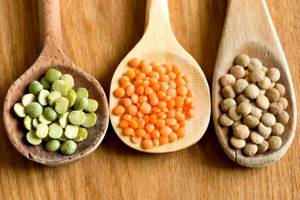
The health benefits of lentils for men and women
Red, green, yellow, orange, brown lentils: benefits and harms, which is healthier?
There are several main types of lentils:
- Brown lentils are the most “popular” lentils. To prepare it, it should be pre-soaked for 0.5-1 days. Mainly, lentils are used for preparing first courses.
- Red lentils are often called “Egyptian lentils.” It is distinguished by its simplicity and speed of preparation. It is good to make purees and stews, soups and porridges.
- Green lentils – often called “French lentils”. This crop is a little immature. It is most often used for making salads.
- Black lentils are distinguished by their small size. It takes the longest to cook and is rich in protein.
- Yellow lentils are a variety of black lentils. It differs only in that it is polished.
- Beluga lentils are the smallest of all varieties and have a dark black color.
- Puy lentils are large, gray lentils with a greenish tint.
- Plate lentils are large, flat lentils that are a light shade of gray with hints of yellow and green.
IMPORTANT: It is impossible to say exactly which lentils are healthier, because all varieties and types have almost the same composition. Therefore, each variety of lentils has important microelements and each is good.

Lentil varieties
general information
Buckwheat porridge appeared on the table of the Slavic peoples a long time ago. Buckwheat was imported from Greece (hence the name), and the region of origin of the nutritious plant is considered to be the Himalayas , on the slopes of which its wild species still grow. Buckwheat was used to prepare dishes, medicinal potions, amulets, and even pillows. And today buckwheat is used quite widely. Consumers can purchase grain crops in the form of kernels, chaff, flakes, flour, and natural grains without processing.
The chemical composition of buckwheat is rich in calcium , sodium , iron , iodine , copper , and zinc . Magnesium, potassium and phosphorus are present in large quantities. The composition includes rare elements: selenium, strontium, titanium and vanadium. Vitamin components are represented in a wide range: A, E, PP, K, group B. Vitamin B4 , present in large quantities ( 54.2 mg per 100 g of product ), of all cereals, is found only in buckwheat. The composition is supplemented with starch, fiber, saturated and unsaturated fatty acids, and amino acids.
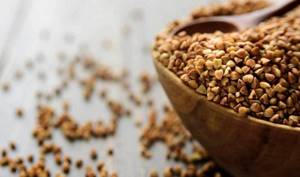
Lentils are the oldest agricultural crop, known to mankind for several thousand years . Now it seems exotic on the Russian table. However, dishes from the most valuable plant of the legume family appeared on the table of our ancestors more than 5 centuries ago. Bread and pies were baked from lentils, stews and porridges were cooked. Healers advised using it as a means to restore mental balance , and included the plant in the recipes of various healing mixtures.
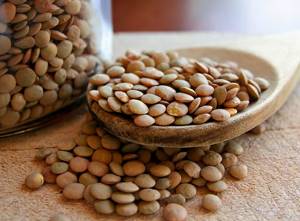
Several varieties are widely used in cooking : large green, red (without shell) and black, similar to fish caviar, lentils. The product of plant origin is rich in easily digestible proteins (60% of the total composition), starch, fiber, vitamins A, C, E, K, and a significant set of group B. Minerals are represented in a wide range: potassium, calcium, phosphorus, magnesium, sodium, iron, chromium, iodine, boron, molybdenum, silicon, selenium and other useful components. No more than 1% fat. The calorie content of 100 g of lentil porridge is 119 kcal . This figure is not much higher than the calorie content of dietary buckwheat cooked in water ( 103 kcal per 100 g ).
Benefits of lentils for children: positive properties
Lentils are considered a very exotic food, and all because it was previously impossible to buy them in a store, and now not everyone will decide to experiment. Nevertheless, this culture is very useful for both adults and children.
Lentils can safely be called a healthy nutrition product . This legume is very useful for children. This is because lentils are a natural source of many vitamins and other important nutrients. The protein that lentils contain is very easily digestible, which means the child will be able to grow and develop properly.
Lentils contain a lot of folic acid. The child needs it in order for him to develop a strong, stable immune system. In addition, folic acid regulates metabolism. Lentils also contain almost all vital minerals that will help form and strengthen the child’s skeletal system, soft tissues, brain and internal organs.
Use in cooking
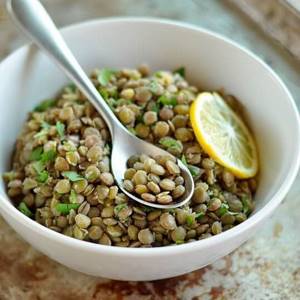
So it’s even difficult to immediately list which dishes you can use lentils for. It is good as an ingredient for soups and with stewed vegetables, and can serve as the basis for vegetarian cutlets. Lentil puree mixed with olive oil, garlic and lemon makes a delicious vegetable pate. Some varieties of this legume are suitable for making cabbage rolls, croquettes, pies, pancakes, dumplings and even a variety of salads.
Remember the benefits of sprouted wheat? A similar “trick” can be done with lentils. To do this, dry seeds must be soaked in cold water and wait until sprouts appear. They are also rich in vitamins and are actively used in Indian cuisine.
At what age can you give your child lentils?
It is important to know that complementary feeding from lentils does not begin immediately, but at the age of 7 to 10 months (depending on how the baby’s intestinal microflora was formed). Start complementary feeding with red lentils (they have the richest taste and are easy to cook), they are very easy to puree in a blender.
Making baby puree is very simple:
- Soak a small amount of lentils in water for several hours.
- Drain the water, add fresh water and boil over moderate heat for 15 minutes.
- You can add a pinch of salt if your child has a picky taste.
- Fry a small amount of carrots and onions in butter.
- Mix with cooked lentils (drain them first).
- Grind the mixture with a blender and add a piece of butter.
IMPORTANT: If your child is not yet over the period of colic or he often suffers from flatulence, postpone complementary feeding from lentils to a later age, as the culture can cause the formation of gas in the intestines.

Is it possible to feed a child lentils?
How to cook lentil soups
Recipes offer several types of soups that include lentils for weight loss. These are both vegetarian and meat soups.
Vegetarian prepared from red lentils:
- You need to boil 200 g of beans and make a puree from them.
- The mass is diluted with broth cooked with vegetables.
- Then a little vegetable oil is added to it.
- The soup is cooked for about 15 minutes and served.
The meat dish is prepared from:
- carrots (1 pc.);
- red onion (1 pc.);
- celery stalk (1 pc.);
- potatoes (2 pcs.);
- ½ l vegetable broth;
- 15 ml cream;
- 200 g chicken fillet;
- 200 g lentils.

- The fillet is fried in a frying pan (you can add a little oil).
- After this, a small amount of water is added to the pan, and the chicken is stewed under the lid.
- Vegetables are being cooked.
- Boiled lentils in a blender are brought to a homogeneous mass.
- By adding vegetable broth to it, you need to make a puree soup.
- A little thyme is added to it, as well as salt and pepper to taste.
- Finally, fillet pieces are placed in the soup.
You can prepare a first course from lentils with the addition of apples and smoked meat. Soup ingredients:
- 200 g cooked beans;
- 100 g smoked meat;
- 1 apple;
- ½ liter of vegetable broth.
Meat and apple are cut into cubes. It all takes 5 minutes to cook. Boiled beans are added to the soup. It cooks for another 5 minutes. The dish can be slightly salted and seasoned with spices.
In Soviet times, our country was a leader in lentil cultivation. But at present, this grain is not in great demand in the diet, but in vain - in terms of protein content, it is in no way inferior to meat. In our article today we will talk about the benefits of lentils for weight loss and what dietary dishes can be prepared using this legume.
The benefits of lentils for pregnant women, can pregnant women eat lentils?
For pregnant women, lentils are an essential food product.:
- Lentils help normalize intestinal function, eliminating constipation. All thanks to the rich fiber content.
- Lentils effectively fight heartburn, which often plagues pregnant women.
- The rich vitamin content strengthens the immune system, increasing its resistance.
- Lentils have a lot of potassium, which in turn has a beneficial effect on the blood-forming organs. As a result, the quality and quantity of blood increases, and anemia disappears.
- Nicotinic acid contained in lentils has a positive effect on the fetus in utero.
- Folic acid not only improves fetal development, but also makes a woman feel good.
- The rich content of vitamins, acids and minerals has a positive effect on the development of the mammary glands and the flow of sufficient milk during lactation.
- Lentils normalize blood pressure, as they contain a lot of B vitamins.
- The satiety that lentils provide will protect a pregnant woman from overeating and gaining excess weight.
IMPORTANT: Lentils contain a unique substance - tryptophan, which is responsible for normalizing hormonal levels and improving mood.

What are the benefits of lentils during pregnancy?
Possible side effects
Lentils are a healthy ingredient for humans. But overindulgence in the product can cause flatulence, and frequent consumption of these beans without sufficient replenishment of the water balance causes constipation. It is undesirable for people with acute gastrointestinal diseases to get too carried away with beans. Lentils contain molybdenum in extremely high concentrations. And this substance, consumed regularly and in large doses, sometimes causes arthritis [8].
You should not feed lentils to your pets. This product can cause fermentation and increased gas formation, and in some cases can even cause their death.
The benefits of lentils for nursing mothers during breastfeeding
During breastfeeding, it is important to give the baby all the nutrients necessary for its development. This happens through breast milk. To be more precise, everything that the mother eats reaches the baby in the form of milk.
When creating a menu, you should take into account the feeding habits of infants. Lentils are a healthy product, no doubt. It contains many vitamins and minerals that will help the child strengthen all body systems and form a strong, stable immune system.
However, you should also pay attention to the fact that lentils are a product that causes flatulence. That is why, in order not to cause discomfort and pain to the baby, you should exclude lentils from your diet until 4-5 months (it is before this period that children experience severe and painful colic).
Nutritionist opinion
To avoid a deficiency of nutrients, nutritionists urge not to get carried away with mono-diets and stick to a varied diet. Give preference to foods that have undergone minimal technological processing: whole grains, non-canned legumes.
Marina Makisha, member of the National Association of Dietetics and Nutritionists: “ Breakfast of oatmeal gives a long-lasting feeling of fullness, but it is important not to overeat: the optimal amount is 3-4 tbsp. l. This will be enough to wait until lunch."
Natalya Ashikhmina, nutritionist of the highest category: “ It is optimal to eat buckwheat porridge weekly, at least three times. If you adhere to a mono-diet, but not longer than 2-3 days. Choose the buckwheat-kefir option for a more complete diet.”
Anna Korobkina, nutritionist: “Black and green lentils are suitable for weight loss. These varieties contain a lot of dietary fiber, normalize cholesterol and remove excess fat from the body.”
Is it possible and healthy to eat lentils if you have type 2 diabetes?
IMPORTANT: Lentils are a must-have food for diabetics not only of type 2, but also of type 1. Lentils are unique in that they not only increase blood sugar levels, but also lower them.
Benefits of lentils for diabetics:
- Lentils contain a lot of healthy “complex” carbohydrates, which are slowly consumed throughout the day and give the body the necessary boost of energy.
- Lentils gently and effectively lower not only glucose levels, but also cholesterol.
- Lentils help improve the digestive process by affecting intestinal motility. Lentils owe this to their rich fiber content.
- Iron increases the level of hemoglobin in the blood, as a result, a person feels better.
- The rich content of amino acids (as well as other elements) helps improve the metabolism of all substances in the body.
- Lentils (or rather its protein) can replace vital microelements that are found in other foods, but are prohibited if a person has diabetes.
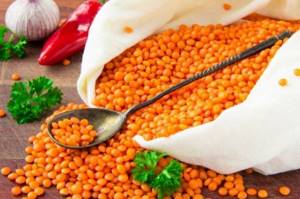
Are lentils good for diabetics?
Recipes
Those who want to improve metabolism in the body, strengthen the immune system, and at the same time get rid of extra pounds and centimeters on the waist, need to reconsider not only their lifestyle, but also their diet and add lentil dishes to the menu. Don't forget to write down the most popular and easy-to-prepare lentil recipes for weight loss in your cookbook.
- Cooking time: 50 minutes.
- Number of servings: 2 persons.
- Calorie content of the dish: 109 kcal.
- Purpose: for breakfast.
- Cuisine: Russian.
- Difficulty of preparation: easy.
To prepare dietary puree, you will need black or red lentils, because these varieties have a more pleasant taste. The bean product must be pre-soaked - this will significantly reduce the cooking time. Lentil puree is very filling and nutritious, so it will help women lose weight and at the same time prevent them from starving.
- lentils – 1 tbsp.;
- onion – 1 pc.;
- oil (vegetable) – 1 tbsp. l.;
- carrots – 2 pcs.;
- spices - to taste.
- Pour water into a saucepan and place on the stove over high heat. When the liquid begins to boil, add a glass of cereal and boil the beans until soft over low heat.
- Chop the onion and grate the carrots.
- Pour a tablespoon of oil into the pan and sauté the vegetables for 2 minutes.
- Add stewed vegetables to the finished porridge, boil everything together for another 5 minutes, add spices, and then stir the mass and turn off the gas.
- Place the mixture of cereals and vegetables into a blender and beat until thick.

- Cooking time: 40 minutes.
- Number of servings: 2 persons.
- Calorie content of the dish: 68 kcal.
- Purpose: for lunch.
- Cuisine: Russian.
- Difficulty of preparation: easy.
When considering lentil recipes for weight loss, you should pay special attention to liquid dishes. Some people prepare this soup with chicken or meat broth, but if you want to get rid of 2-3 extra pounds, use vegetable broth. Dietary lentil soup will have a wonderful smell if you sprinkle it with herbs. To make the dish more satisfying, you can additionally add croutons grated with garlic to the plate.
- allspice – 3 peas;
- salt – 1 tsp;
- bay leaf – 1 pc.;
- onion – 1 pc.;
- tomato paste – 1 tbsp. l.;
- black pepper - a pinch;
- red lentils – 200 g;
- olive oil – 1 tsp;
- rice – 2 tbsp. l.
- Cut the peeled onion into cubes. In a frying pan with olive oil heated, fry the cubes until golden brown.
- Add a spoonful of tomato paste to the onion and simmer for another 3 minutes.
- Boil the rice and lentils for 10 minutes, pouring them into boiling water.
- Add onions stewed in paste to the prepared cereals, add spices to the future dish, add salt. Having brought to a boil, turn off the gas.
- You can pour the soup into a bowl and serve, garnished with a sprig of parsley.
Is it possible to eat lentils if you have pancreatitis?
Pancreatitis is a serious disease characterized by inflammation of the pancreas. Of course, the benefits of lentils, like other legumes, are great, but this crop (like peas, chickpeas and beans) is completely excluded from the menu of a patient with pancreatitis, especially if the patient is in the stage of acute illness.
Fiber, which is abundant in lentils, can adversely affect the functioning of the stomach and that is why eating this crop is prohibited. The pancreas will not be able to produce the required amount of necessary enzymes, which means the person will experience severe pain and indigestion.
IMPORTANT: There is one exception that allows a patient with pancreatitis to eat lentils in limited quantities. This is remission. At this time, the patient eats the “common table” menu. Lentils should be boiled well before taking and consume no more than 1-2 tbsp. once a week.

Who can eat lentils? When should you not eat lentils?
Lentils for gastritis: how to eat correctly?
If you have gastitis, you can eat lentils. Moreover, it is recommended to eat green crops. This is because this type contains a lot of isoflavones. This substance actively fights cancer cells throughout the digestive tract: stomach, intestines. A unique feature of lentils is its ability not to lose nutrients even during heat treatment.
If you have gastritis, you can eat sprouted, dry, boiled and even canned lentils. Lentils are also good because this crop is not capable of accumulating toxic substances found in the environment. Therefore, lentils can be safely called an environmentally friendly product.
Lentil recipes for weight loss
In addition to its excellent fat-burning effect, lentil dishes are easy to prepare and require a minimum of time and culinary skills.
Light lentil soup
Lentil soup is ideal for lunch and dinner when on a diet. To prepare this dish we will need:
- red lentils – 230 gr;
- onions – 70 g;
- tomato paste – 50 g;
- zucchini – 80 gr;
- olive oil – 10 g;
- salt, pepper - to taste.
Pour 1.5 liters of water into a saucepan, bring to a boil and add lentils and zucchini there, after cutting it into cubes. Cook for 10-15 minutes. Meanwhile, fry the onion and tomato paste in olive oil. Then add the fry to the lentils and cook for another 5-7 minutes over medium heat.
Lentil and vegetable porridge
Lentil porridge prepared according to this recipe is recommended for breakfast. Of the ingredients we need:
- red lentils – 200 gr;
- vegetable broth or water – 700 ml;
- carrots – 1 piece;
- garlic – 3 cloves;
- dill – 20 gr.
Add washed lentils and broth to a thick-bottomed saucepan. Place on low heat and simmer until half cooked for 30-45 minutes. Then add grated carrots and chopped garlic and cook for another 10-15 minutes. At the end of cooking, add fresh dill.
Warm lentil salad
To prepare a warm salad, use freshly cooked green lentils. So, we need:
- boiled lentils – 150 g;
- fresh pumpkin – 120 gr;
- mozzarella cheese – 50 gr;
- tomato – 1 piece;
- vegetable oil and salt - to taste.
Cut the pumpkin into strips and fry for 10 minutes in a frying pan. Then we transfer it to a salad bowl, add mozzarella, chopped tomato and lentils. Season with vegetable oil and salt, mix.
Fluffy lentil casserole with kefir
A small portion of lentil casserole with kefir is ideal as an afternoon snack on a bland diet. To prepare this delicacy we will need:
- boiled red lentils – 200 g;
- low-fat kefir – 250 l;
- garlic – 2 cloves;
- zucchini – 150 g;
- salt, pepper - to taste.
Grate the zucchini and garlic, then add the lentils and spices. Mix thoroughly and pour the resulting mass into a mold previously greased with vegetable oil. Pour kefir on top and place in an oven preheated to 200 degrees for 15-20 minutes.
When choosing lentils, pay attention to the date of harvest and packaging. The fewer grains are on the shelves, the more nutrients they contain.
Lentils: benefits and harm to the liver
A unique feature of all legumes, including lentils of any variety, is the content of lecithin amino acid in large quantities. This substance has a very beneficial effect on the functioning of the liver and its health, helping to restore normal cells of the organ. However, eating it in excessive quantities is not recommended. Diversify your menu with lentils and cook dishes from them about 1-2 times a week.
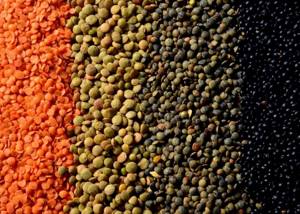
What are the unique features of lentils?
Contraindications
Buckwheat-based dishes are not recommended for consumption:
- Patients with gastrointestinal pathology.
- Patients with blood clotting problems.
Lentil dishes are not recommended to be included in the diet for people suffering from:
- Diseases of the digestive tract.
- Hemorrhoids in the acute phase.
- Urolithiasis.
- Pathology of the cardiovascular system.
- Joint diseases.
With caution and small doses, you can add legumes to the menu of children and the elderly . The body of these age groups has a hard time tolerating excessive amounts of purine contained in the plant.
Lentils in bodybuilding: what are they good for?
Lentils, like other legumes, are rich in natural protein, which is very similar to animal protein. It differs only in that it is easier to digest and the lentils themselves do not contain fat. Regular consumption of lentils will allow a bodybuilder to take care of his muscles, because the culture is rich in all vital microelements.
IMPORTANT: In addition, lentils are filling and can provide the body with the necessary supply of calories for a long period of time. That is why eating lentils is useful before and after heavy physical activity.
Is it possible to give lentils to children?
Medical sources equate lentils to any other legumes. It is believed that a child’s body is ready to digest such food from 7 months, but complementary feeding should be started gradually. Most authors agree that 7 months is the exception, and the rule is to start feeding lentils from 1.5 years. Lentils can not only cause flatulence in a child and indigestion, but also provoke an allergic reaction.
Lentil puree is introduced gradually, focusing on the reaction of the child’s body. Changes in stool and well-being are usually monitored. Flatulence and diarrhea should serve as a signal to exclude dishes from the diet. An allergic reaction often manifests itself in the form of rashes, this is also worth keeping in mind.
Complementary feeding begins with softer varieties, for example, red or yellow lentils, gradually transferring the food to the format of something harder, and introducing green or brown cereals.
What do you eat lentils with?
Lentils go well in taste with:
- Meat of any type and variety (however, it is preferable to choose low-fat varieties).
- Butter, cheese, sauce - these products will favorably emphasize the nutty taste of the crop.
- With vegetables , the crop can act as the main dish and its taste can be emphasized by fresh, stewed or canned vegetables.
- With legumes - boiled, stewed or canned.
